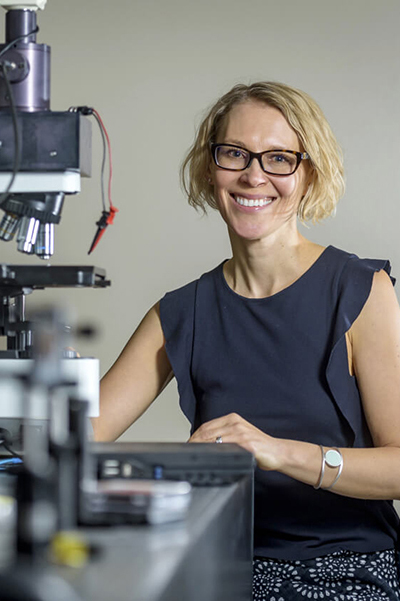Study: First observation of high-harmonic generation in robust, refractory metals

Key research finding
The generation of high harmonics from metals opens a link between solid and plasma harmonics. High-harmonic generation (HHG) is the field of creating high-frequency photons from low-frequency lasers. HHG is the cornerstone of nonlinear optics, with applications in spectroscopy, attosecond science and so on. In this study, researchers used titanium nitride to achieve HHG in refractory metals for the first time. In the future, this could pave the way to focusing the radiation down to nanoscale for use in nanomachining, nanofabrication and medical applications, as well as HHG enhancement for the generation of frequency combs for the next generation of nuclear clocks.
Purdue professor, title
Alexandra Boltasseva, the Ron and Dotty Garvin Tonjes Professor of Electrical and Computer Engineering. Boltasseva’s interdisciplinary work merges nano-optics, materials science and machine learning to enable a new generation of devices for ultra-fast, ultra-thin optics, denser photonic/quantum circuitry and data storage, harsh environment sensing, biomedical applications, energy conversion and room-temperature, efficient quantum devices.
Vladimir M. Shalaev, the Bob and Anne Burnett Distinguished Professor of Electrical and Computer Engineering and scientific director for nanophotonics at Birck Nanotechnology Center in Purdue’s Discovery Park. Shalaev is recognized for his pioneering studies of linear and nonlinear optics of random nanophotonic composites, artificially designed and engineered optical metamaterials, plasmonics and quantum photonics.

Journal name
Nature Communications, Abstract is available online. High-harmonic generation in metallic titanium nitride
Funding
The work was funded by U.S. Defense Threat Reduction Agency (DTRA) and the University of Ottawa, NRC Joint Centre for Extreme Photonics (JCEP), with contributions from the U.S. Air Force Office of Scientific Research (AFOSR) (awards FA9550-16-1-0109, FA9550-18-1-0002, FA9550-20-1-0124) and Office of Naval Research (ONR) (grant N00014-20-1-2199), Canada Foundation for Innovation, Canada Research Chairs (CRC) and the Natural Sciences and Engineering Research Council of Canada (NSERC).
Brief summary of methods
Researchers combined titanium nitride, a refractory metal pioneered by the Shalaev-Boltasseva research groups, that has an exceptionally high laser tolerance, with extremely short laser pulses consisting of a mere few electric field oscillations. Titanium nitride’s 10-times larger laser tolerance than gold enabled researchers to hit it with high intensity radiation, emitting shorter wavelength light at up to 110 nm, in the vacuum ultraviolet regime for the first time in a metal.
Source: Study: First observation of high-harmonic generation in robust, refractory metals
